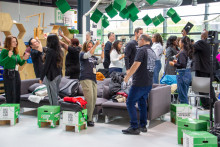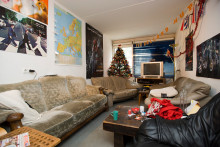One of the questions Horn is approached with by agencies, is: How do we make sense of all the mess surrounding a problem? Horn’s answer is to illustrate a ‘mess map’. A mess map is a visual analysis of big issues, often as massive as entire walls in a room.
‘All of us are overloaded with information, we need to make it clearer,’ began Horn. ‘A lot of the information is fragmented. Intelligence agencies often try to connect the dots, but to me those dots are more like smudges since the information is not clear. To illustrate these smudges I draw blobs. Blobs are very important since they are an indication of the extent of the fragmentation of knowledge or information. Drawing squares simply doesn’t work with other people, squares remind them of engineers.’
Visualising a sustainable world
To illustrate the scale on which Horn operates, he provided a practical example. The question was: what does a sustainable world look like? ‘To answer this question you have to define sustainability first,’ said Horn. ‘Which in this case is 9 billion people living well and within the limits of the planet. 29 major companies joined in on the taskforce including Philips and Volkswagen. 400 requirements were needed to achieve sustainability with 70 different measures of success. Including 40 must-haves just this decade.’ Horn and his colleagues visualised all of this data into one single picture. The process they used to achieve this feat is called backcasting. Backcasting starts with the questions If these are the goals of 2050, what has to be in place in 2040 to achieve the goals of 2050?
Horn added that ‘an organisation does not know everything’. ‘And keeping track of everything in complex issues is extremely hard. This is known as the unknown challenge. It is like scientists walking in the dark with their flashlights, all of them illuminating small parts of a problem on the walls and ceilings. Finding out how these problems interact is often a challenge.’
‘We have already exceeded three planetary boundaries’
‘A smaller part of the sustainability issue is that Europe cannot sustain itself. It does not have sufficient raw resources and agriculture. How do we get towards a sustainable Europe, what are our goals, limits, important planetary boundaries that we have exceeded and which ones are about to be exceeded? These are important questions. We now know that we have already exceeded three planetary boundaries, and that four more are underway of being exceeded. We got to have decision rooms with murals on all sides so you can zoom in on the smaller issues of a bigger problem. These murals should be easily transformable once new information becomes available. I am happy to see that the technology is getting there to allow for these type of murals.’







